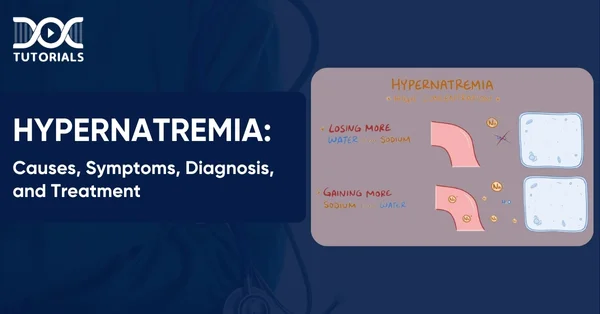Hypernatremia: Causes, Symptoms, Diagnosis, and Treatment

Hypernatraemia is a disorder in which the salt level in the blood is too high, causing an imbalance in the body that is usually caused by dehydration or loss of too much fluid. This illness needs to be diagnosed and treated promptly, regardless of whether it is caused by insufficient fluid intake, excessive fluid loss through the digestive system, or the use of diuretics.
It’s significant for medical students preparing for the NEET PG exam to understand the basics of hypernatraemia. DocTutorials has all the NEET PG materials you need to prepare for the topic for the comprehensive exam for future doctors.
Read on to find out more about hypernatraemia, including what causes it, how to recognise it, and how to treat it.
What is Hypernatremia?
Hypernatremia is a pathological state in which the level of sodium in the blood is higher than normal, typically above 145 milliequivalents (mEq) per litre. Although the majority of sodium exists in the blood and lymphatic fluids, having an appropriate balance with water is essential to keep a person healthy.
Hypernatremia most commonly develops when the body loses more water than sodium, typically through dehydration but occasionally through excessive salt consumption or underlying illness. In most instances, the condition is mild and controlled, but if it goes untreated, complications such as neurological damage can arise.
What are the Symptoms of Hypernatremia?
The common symptoms of hypernatremia can range from mild to severe. Here are some of those symptoms listed below:
- Excessive thirst (most prominent and early symptom)
- Restlessness or increased irritability
- Lethargy and extreme fatigue
- Confusion
- Muscle twitching or spasms, as sodium affects muscle and nerve activity
- Skin may feel doughy or velvety due to water loss
- Rapid heartbeat (tachycardia)
- Low blood pressure (hypotension)
- Strong or exaggerated reflexes
- Seizures
What are the Causes of Hypernatremia?
Hypernatremia or high sodium levels in the blood is most likely caused by either a deficit of free water, an excess of sodium, or a combination of both.
Discussed below are the causes of hypernatremia:
- Inadequate fluid intake
- Excessive fluid loss
- Kidney dysfunction
- Uncontrolled diabetes mellitus
- Diabetes Insipidus
- Nasogastric drainage or tube feeding for a distant period
- Administration of diuretics or certain drugs can increase the loss of water through urine and increase blood sodium levels.
What are the Risk Factors of Hypernatremia?
People who are at a higher risk of developing hypernatremia include:
- Infants, especially breastfed infants, who are not fed well enough.
- Older adults, who often have reduced thirst responsiveness due to age-related physiological changes, in addition to having a higher prevalence of chronic illness.
- People with altered mental status; altered mental statuses can include delirium, dementia, and unconsciousness.
- Individuals receiving IV (intravenous) fluids or food via tube feeding.
- Individuals with impaired kidney function.
Individuals consuming certain medications that include lithium, diuretics, corticosteroids, etc. These medications can affect the hormones and conditions implicated in sodium absorption.
- People with hyperaldosteronism have a higher possibility of developing hypernatremia.
- Older people who do not drink sufficient water.
How to Diagnose Hypernatremia?
Diagnosis of hypernatremia involves the determination of high sodium blood levels and the identification of the cause behind the disturbance in balance. Here are the major diagnostic methods:
- Blood Tests: The main method of diagnosing hypernatremia is through blood tests, which determine high serum sodium levels (above 145 mEq/L).
- Urine Tests: Urine tests can also be conducted to assess the sodium concentration of the urine and the osmolality, differentiating renal from non-renal causes of fluid loss.
- Assessment of Medical History: Physicians typically obtain a thorough medical history to evaluate risk factors, including fluid consumption, recent illnesses, medication use, and pre-existing health conditions such as kidney disease or diabetes.
- Physical Examination: Physical examination identifies clinical clues of dehydration, altered mental status, or neurological involvement.
- Additional Tests: In a few instances, further testing or imaging (chest X-ray or CT scan) is necessary to assess related complications or contributory disorders such as brain oedema, hormonal imbalance, or infection.
How to Treat Hypernatremia?
The hypernatremia treatment aims at re-establishing the fluid and sodium levels of the human body. Therapy varies depending on the time taken by the condition to develop and its cause. Less severe forms might be treated merely by elevating fluid consumption through the mouth.
Severe or more rapidly evolving forms of hypernatremia usually need intravenous (IV) fluids to slowly diminish sodium levels. It is essential not to reduce sodium too rapidly, as this can lead to brain swelling (cerebral oedema).
Apart from these, physicians strictly monitor the sodium levels of the patient while on treatment and treat any underlying cause, like diabetes, kidney impairment, or loss of fluids, to avoid recurrence.
FAQs About Hypernatremia
- What is the most severe complication associated with hypernatremia?
The most severe complication of hypernatremia results from brain dysfunction. In serious situations, it can lead to confusion (delirium), muscle twitching (myoclonus), seizures, coma, and death.
- What type of fluid is most suitable for treating hypernatremia?
For patients experiencing hypernatremia of prolonged or uncertain duration, it is advisable to lower the sodium concentration gradually. Intravenous 5% dextrose should be administered for acute hypernatremia, while half-normal saline (0.45% sodium chloride) is recommended for chronic hypernatremia.
- What medical conditions can lead to hypernatremia?
There are various medical conditions that can result in hypernatremia, with diabetes mellitus being a prevalent cause. Other conditions that may contribute to hypernatremia include chronic kidney disease, diabetes insipidus, and Cushing’s syndrome.
- What is the appropriate correction rate for hypernatremia?
Chronic hypernatremia without or with mild symptoms must be corrected at not more than 0.5 mEq/L/h, with an overall correction of 8-10 mEq/L/d.
- What is the hypernatremia correction formula?
The formula associated with hypernatraemia correction is: Replacement volume (in L) = TBW deficit × 1 ÷ [1 – (Na concentration in replacement fluid in mEq/L ÷ 154 mEq/L)].
Conclusion
Hypernatremia is a severe electrolyte imbalance caused mainly by water loss and may lead to life-threatening situations unless diagnosed and treated early. Having comprehensive knowledge about its pathophysiology, clinical presentation, and management is crucial for aspiring doctors.
DocTutorials is a trusted academic platform for NEET PG aspirants, providing masterfully developed physiology material and other study materials in line with real-life clinical issues and NEET PG examination standards.
Join DocTutorials and explore our NEET PG course to excel in your medical career.
Latest Blogs
-

NEET PG Exam 2025- Date, Pattern, Marking Scheme, Subject Wise Weightage, and Exam Mode
NEET PG Exam 2025 is the ultimate gateway for medical graduates aspiring to pursue postgraduate courses in medicine, including MD,…
-

INI CET Exam 2025: Your Roadmap to Success – Key Topics, Strategies, and Lessons from Last Year’s Papers
The INI CET exam is more than just a test; it’s a significant milestone for many medical students aiming to…
-

INI CET Exam Success: Previous Year Question Papers & Ultimate Guide – INI CET PYQ
One can feel overwhelmed while preparing for the INI CET (Institute of National Importance Combined Entrance Test). A vast syllabus,…




